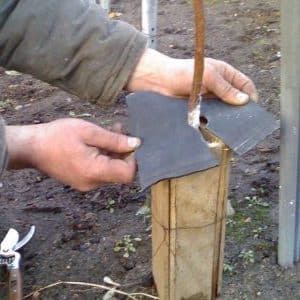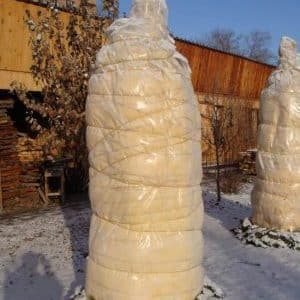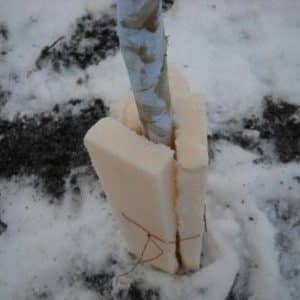How to properly cover an apricot for the winter and prepare the tree for cold weather
Sweet and juicy apricots, absence of diseases and pests, strong branches - all this is easy to achieve if you provide the tree with proper care. Apricot is an unpretentious crop, but in order to reap a good harvest in the warm season and avoid problems with pests, you need to properly prepare the tree for the cold.
How to cover an apricot for the winter, what care to provide it in the fall and other seasons - read on.
When is it time to cover apricots for the winter?
Considering that apricot is not a frost-resistant crop, it is prepared for shelter long before the onset of frost. As soon as the harvest is harvested, you can begin preparatory work - trimming, fertilizing, choosing material and deciding on the covering method.
When all the preparatory work is completed, the trees are covered. As a rule, by this time the average daily temperature drops below +8°C.
Preparatory work

Work begins at the end of September or beginning of October. Tree preparation is carried out in several stages:
- Before the temperature at night drops below +8°C, preventative pruning is carried out and the crown is formed for the next season. The remaining bark is removed from the trunk, and all dried and overgrown branches are cut off. The cut areas are treated with garden varnish or Bordeaux mixture.
- Next, the trees are fertilized. Most often, wood ash is used for this (a glass in a bucket of warm water).The ash solution will not only protect the plant from diseases and feed it, but will also prevent untimely growth of shoots and bud opening in the event of a warm autumn.
- The last stage is mulching the soil. The ground around the trunk is sprinkled with a mixture of sawdust, sand and peat (humus).
At the end of summer, before preparatory work, nitrogen fertilizers should not be applied to the soil.
What to choose as a covering material
The choice of covering material depends on the apricot variety and region of growth.
A universal option is ordinary mulch. This can be large coniferous sawdust, dry leaves, straw, cardboard scraps, as well as the remains of any covering materials.
Important! Remember that the mulch used to cover apricots for the winter must be completely dry.
If the region is characterized by severe night frosts, it is best to sprinkle the soil around the tree with a thick layer of dry soil, and cover everything on top with spruce branches.
In regions with a temperate climate, materials such as agrofibre, lutrasil, and burlap are more often used.
Polypropylene bags also retain heat well, but do not let air into the soil. Therefore, they should be placed so that at least small areas of the ground remain open. And to prevent cold air from damaging the plant through them, breathable material is used.
How to properly cover an apricot for the winter
To provide trees with a comfortable winter, a number of important recommendations are followed.
Covering methods
The choice of covering method is the choice of covering material, as discussed above. But there are several nuances here. Thus, covering a tree with non-woven and special materials is carried out only under the trunk on the soil or covers part of the trunk. The second option is more preferable for cold regions where young apricots grow.
You can also combine mulching and the use of artificial materials. In this case, it is better to put more mulch and cover everything on top with agrofibre or other material, securing it from gusts of wind.
Step-by-step instruction
When working, it is important to follow the sequence of steps:
- Preparing the tree itself.

- Loosening the soil around the trunk.
- Mulching the soil.
- Adding an additional thick layer of mulch at a distance of at least 1-1.5 m around the trunk.
- Laying covering material and wrapping the trunk if necessary.
If the tree was often sick and was attacked by pests, it is advisable to whiten the trunk before sheltering.
Mistakes to Avoid
There are three main mistakes that are best avoided:
- wrapping and covering with thick layers of non-breathable material;
- too much watering in the fall;
- very tight tying of the crown to the trunk with covering material.
Any of the errors leads to rotting of the roots or shoots, the development of fungal diseases and the death of the plant. But insufficient shelter from the cold will ultimately lead to freezing and death of the tree, so it is important to maintain a balance.
Nuances for young and old trees
It is recommended to cover young low trees completely for the winter. To do this, a frame is constructed from sticks, onto which agrofibre is stretched.
Old trees do not need such a frame; covering the soil around them and wrapping the trunk up to the crown is sufficient.
This is interesting:
Instructions for transplanting honeysuckle to a new place in stages.
When and how to properly transplant grapes to another place in the fall.
Features of winter shelter depending on the growing region

The colder the region, the more protection the tree needs from frost.
In southern latitudes, apricots are often left uncovered for the winter, limited to mulching the soil. But if severe night frosts persist for more than three days, the trunks are wrapped with durable film or agrofibre.
In mid-latitudes (for example, in the Moscow region), mulching and wrapping trunks is done immediately. For winding, it is better to use not film, but a natural material that allows air to pass through well - thick paper, agrofibre. You can also tie straw to the trunk. Small trees are protected with frames with stretched agrofibre.
In northern latitudes, where winters are harsh, several materials are used for shelter, and all layers are made thicker.
Important! In conditions of snowy and frosty winters, in addition to insulating trees, they provide drainage of water that will form during the melting process.
To drain water, small trenches are dug from the trunk so that water does not stagnate near the tree. Otherwise, the apricot roots may rot.
What other stages of preparation for winter does an apricot tree need?
If trees often get sick, it is recommended to additionally spray them with Bordeaux mixture, a weak solution of copper sulfate or potassium permanganate before covering them. Also, a few days before insulation, the soil is moistened to a depth of 0.8-1 m so that the earth does not completely harden.
Reference. If you whitewashed the trunk along with the branches, it will only be enough to insulate the soil around it without wrapping the trunk and branches with covering material.
Conclusion
Sheltering apricot trees for the winter is an integral part of care.Proper insulation will protect the crop from many diseases and pests and protect it from frost, providing the plants with a comfortable winter and a good harvest.